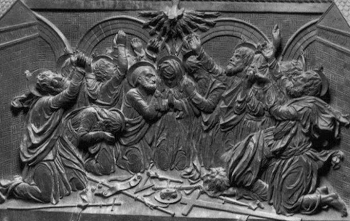Precise Days of Worship
Six of God's seven Holy (Feast) day periods have an exact date given in the Bible on which they are to occur on the Biblical (Hebrew) calendar.
Passover is always to begin in the first sacred month at sunset at the start of Abib (Nisan) 14 (Leviticus 23:5). The first day of the Feast of Unleavened Bread, the first high day of the year, is to commence at the start of Abib (Nisan) 15 (Exodus 23:15, 34:18, Leviticus 23:6) with the Last Day of Unleavened Bread beginning at the start of Abib 21.
The Feast of Trumpets (Rosh Hashanah) must always begin on the first day of the seventh sacred month or Tishri 1 (Leviticus 23;24). The Day of Atonement (Yom Kippur) is to be celebrated on Tishri 10 (verse 27). The Feast of Tabernacles is to begin on Tishri 15 (verse 34) with the Last Great Day celebrated on Tishri 22.

Pentecost, however, the third of seven Feast day periods, is a unique "floating" high Feast day. Its observance is not fixed to a particular date on the Biblical calendar. It is called the "Feast of Weeks" (Exodus 34:22) because weeks must be counted each year to arrive at when Pentecost should be observed.
Determining Pentecost
Pentecost is determine each year by counting seven sets of seven complete weeks (sunset Saturday to sunset Saturday), or 49 days, beginning with the FIRST Saturday sunset that begins one of the Days of Unleavened Bread (Leviticus 23:15 - 16).
The first day of the count to Pentecost is known as the Wave Sheaf day (Leviticus 23:11 - 12) which must always fall within Unleavened Bread.
After seven weeks are counted (which contain seven weekly Sabbaths) the fiftieth day, which runs from sunset Saturday to sunset Sunday, is declared Pentecost.
Fascinating Variations
An analysis of the Biblical calendar from its start in the fall of 3761 B.C. to the present reveals interesting information about Pentecost. The calendar shows that this high Feast day is unlike all others!
The beginning of all the other Feast periods (Passover, Unleavened Bread, Trumpets, Atonement, Feast of Tabernacles) occur throughout history within a maximum range of 47 Julian/Gregorian calendar days.
The Feast of Trumpets (Tishri 1), for example, has occurred as early as sunset August 24 in years 1348, 1405, 1481, 1500 and 1576 A.D. The latest this high holy day has occurred is sunset on October 9 in years such as 3696 and 3677 B.C.
Pentecost, however, is different. The earliest it has ever started is at sunset on May 2 in 1405 and 1500 A.D. Its latest start throughout history was on June 22 in 3677 and 3430 B.C. This gives us a potential range with which Pentecost can occur of 52 Julian/Gregorian days!
Additionally, while the other Feast day periods can begin on various days of the week, Pentecost will always begin at sunset on a Saturday.
The last fascinating fact about Pentecost is that although it can occur within the months of May or June, it will always be celebrated in the Biblical month of Sivan.
Why?
The first sacred month of the Biblical calendar, Nisan (Abib), always has 30 days. The next month, Iyar, always has 29 days. The third month, Sivan, always has 30 days. No matter when the count to fifty begins during the Feast of Unleavened Bread, unique Pentecost is guaranteed to fall within Sivan!